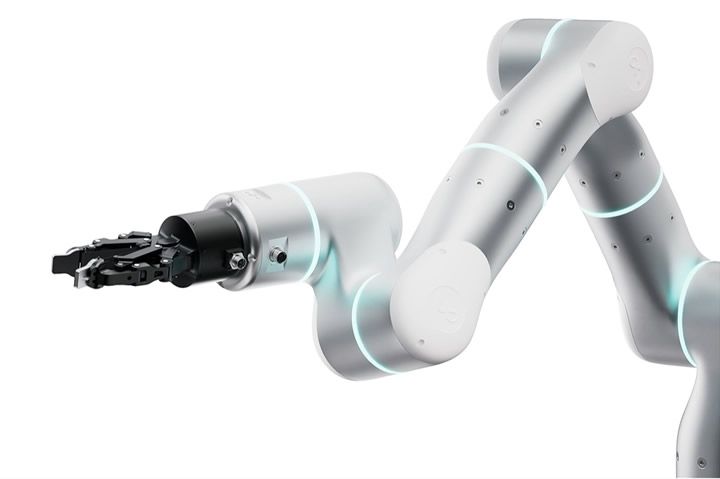Adaptive robots redefine what's possible in automation by seamlessly blending industrial-grade force control with artificial intelligence. Simple to program, they think, sense, and adapt to effortlessly handle complex environments and diverse tasks with ease.
 Adaptive Robots
Adaptive Robots

Q&A with Xiyang Yeh, Co-Founder and CTO | Flexiv
Can you tell us about yourself and your role with Flexiv?
I'm Xiyang Yeh, the Co-Founder and CTO of Flexiv. At our core, Flexiv is focused on developing general-purpose adaptive robots—machines that combine high-performance force control, AI, and computer vision to operate effectively in unstructured, dynamic environments.
As CTO, I work closely with both the hardware and software teams to shape the strategy behind our core robotic systems—from hardware and software architectures to the development of SDKs that empower our partners to build robust robotic solutions for automating complex tasks.
Today, our adaptive robots are being applied across a range of industries—from manufacturing and agriculture to healthcare and service. It's been exciting to watch our technology evolve from concept to real-world impact.
What led to the development of your adaptive robots?
The idea behind our general-purpose adaptive robots came from a clear gap in traditional automation—robots excel in structured environments but struggle with variability, which is increasingly common in today’s industries.
As humans, we constantly adapt to changes while performing various tasks—we adjust our force, movement, and decisions in real time, relying primarily on our senses. In particular, when it comes to manipulation, we depend heavily on feedback from our sense of sight and touch. This enables us to perform highly dynamic, contact-rich tasks such as precision assembly of wire connectors, fine surface polishing, and handling fragile food items.
Flexiv was founded with the mission to close this gap by developing general-purpose adaptive robots capable of bringing human-level adaptability to automation.
What technology enables a robot to be adaptive?
Adaptive robots rely on a combination of computer vision, force control, and advanced control to operate effectively in dynamic, unstructured environments. Computer vision provides real-time perception, enabling the robot to recognize objects, understand its surroundings, and handle variations in position or orientation. Thus far, we have integrated perception solutions from multiple companies.
Force control allows the robot to sense and respond to physical interactions, adjusting its motion based on contact forces—much like how humans feel and adapt when assembling objects. The core piece in force control is the force and torque sensors. At the heart of this capability are force-torque sensors. Traditional sensors often suffer from temperature drifts, so we invested significant effort into designing sensors that remain stable across a wide range of temperatures.
Finally, we engineered our software to seamlessly work with both sensing modalities, allowing our robot to perform vision or force guided motions. This enables us to program reusable skills, whether it is reach for an object, align to a surface or assemble a connector.
What sets an adaptive robot apart from a collaborative robot?
Collaborative robots, or cobots, offer an easy-to-use programming interface along with a suite of safety features that can be configured to ensure human operators are adequately protected. This combination enabled cobots to work directly alongside humans.
At Flexiv, we aim to go one step further by building robots that are safe and general-purpose. These robots must be able understand its surroundings and interact with its environment safely and compliantly—in other words, they must be adaptive. An adaptive robot is defined by three key properties.
First, an adaptive robot can compensate for position errors, for example, dealing with objects whose locations or geometric tolerances are uncertain. Second, it must be capable of handling unpredictable disturbances, such as vibrations from tools, abrupt stops from autonomous mobile robots (AMRs), or maintaining consistent performance despite tool wear, as seen in sanding applications. Finally, it should possess transferable intelligence, meaning that programmed or learned skills can generalize across a wide range of scenarios, for instance, a connector insertion skill that works for many different types of connectors.
Are there any tasks or applications where adaptive robots particularly excel?
Adaptive robots particularly excel at compensating for uncertainty and variation—conditions that are common in most real-world tasks. Among them, the two that are most suited for adaptive robots is assembly and surface processing.
In assembly, one of the most impressive examples developed by our engineers is the precise installation of components in home appliances as they move along conveyor systems. Both part variability and motion introduce complexity for traditional automation solutions.
In surface processing, we have developed a lot of polishing and grinding solutions for customers in the automotive industry, whether it is removing weld spots from the car chassis, ironing faux leather seats and buffing panels
Are there any tasks or applications where adaptive robots particularly excel?
Adaptive robots particularly excel at compensating for uncertainty and variation—conditions that are common in most real-world tasks. Among them, the two that are most suited for adaptive robots is assembly and surface processing.
In assembly, one of the most impressive examples developed by our engineers is the precise installation of components in home appliances as they move along conveyor systems. Both part variability and motion introduce complexity for traditional automation solutions.
In surface processing, we have developed a lot of polishing and grinding solutions for customers in the automotive industry, whether it is removing weld spots from the car chassis, ironing faux leather seats and buffing panels
What are the key advantages or disadvantages of adaptive robots?
Adaptive robots offer great flexibility in unstructured settings, adjusting to part misalignments, variable object shapes, or unexpected forces. This makes them well suited for a wide range of tasks, including food handling and healthcare
Using force/torque sensors, adaptive robots provide improved safety around people. These robots can sense and react to gentle touches, enabling users to easily guide by hand and teach detailed movements.
However, adding force/torque sensors does make the system more complex. I still think it is a great idea as it unlocks many new possibilities in automation. One of the most common things we hear from customers is, 'I didn’t know this could be automated!'
Looking forward a few years, what advancements do you see in adaptive robots and how is Flexiv involved?
Although we build adaptive robots in the form of robotic arms, our technologies are fundamentally robot-agnostic. The benefits of adaptivity extend well beyond arms—we see similar advantages when applied to grippers, autonomous mobile robots (AMRs), and even multi-arm systems. Over the years, we’ve expanded our product offerings to support a broader ecosystem and will continue to do so.
Recently, there has been a surge of investment in Physical AI, where AI and robotics are tightly integrated into unified products. In this evolving landscape, we see ourselves as a platform company—offering core technologies such as force control, perception, simulation systems, and AI models. These technologies enable our partners to build robotic systems that operate safely, compliantly, and intelligently across a wide range of environments.
The content & opinions in this article are the author’s and do not necessarily represent the views of RoboticsTomorrow
Comments (0)
This post does not have any comments. Be the first to leave a comment below.
Featured Product

